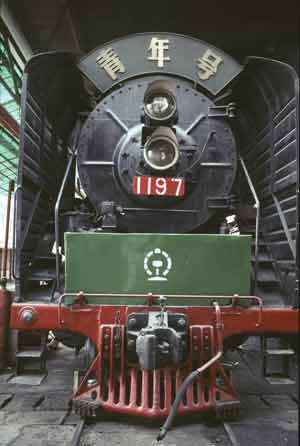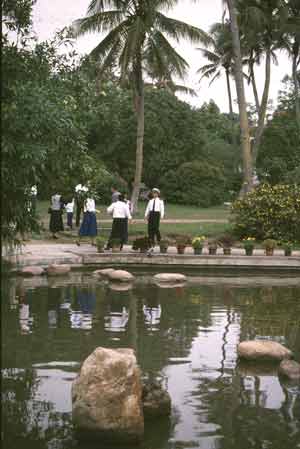| 美丽新广东与旅人的亲密接触(图) | |
| http://www.sina.com.cn 2004/07/27 12:39 中国周刊 | |
Southwest Guangdong - a railway opens up this beautiful area to travellers By Bruce Connolly
When I first came to here in 1987, by rail overland from Scotland, I eventually arrived in Guangzhou. A comfortable train carried me onwards to my ultimate destination, Hong Kong. At that time this was Guangdong's one main railway, connecting it with the rest of China. A branch line did go west from Guangzhou to the cities of Foshan and San Shui. In the province's far west another line connected neighbouring Guangxi with the port of Zhanjiang and the oil producing city of Maoming. Much of Guangdong at that time was relatively inaccessible - roads were poor and journeys long. Thanks to nature the region did have an important, though slow, lifeline - its river system. Hong Kong sits at the mouth of the Pearl River (Zhujiang). Feeding into the great estuary is a maze of navigable waterways that for centuries carried almost all of southern China's traffic, human and freight. It is one reason why the Pearl River Delta has long been so economically important. The principal stream, the West River (Xi Jiang) extends its tentacles right through Guangxi, even reaching close to Vietnam. It also provided a route over many years for adventurous foreign travellers going to the magnificent scenery around Yangshuo - by overnight boat from Guangzhou to Wuzhou in Guangxi, followed by a long bus ride. Travelling downriver was reasonably fast, but going upriver against the current could be agonisingly slow In only a few years the situation in Guangdong has changed dramatically. Many passenger river journeys are now a distant memory although the waterways are still important for bulk freight movement. Recent construction of an excellent network of expressways has now brought many county towns within a few hours drive of Guangzhou. An ongoing investment in rail construction has not just opened up remote areas in the province but also improved communications throughout southern China. The San-Mao railway A major infrastructure project was the San-Mao railway. Financed largely through loans from the Asian Development Bank, it was completed in December 1990. Bridging the 231-kilometre gap between San Shui and Maoming the line started full operation on 28 March 1991. Previously rail travel between Guangzhou and Guangxi's capital Nanning was a long and circuitous journey. First north up to Hengyang in Hunan and then back down to Guilin. Today it is a short overnight run along the San-Mao. The opening of the Nanning-Kunming (Nan-Kun) railway in the late '90s also meant much shorter journeys from Yunnan to Guangdong. This railway is particularly vital in connecting recent rail developments on Hainan with the Pearl River Delta.
Personally, the San-Mao railway has given me many happy memories and opened up the relatively unexplored world of SW Guangdong to my travels. In the 1990s the San Mao was a rail enthusiast's dream because steam-powered locomotives hauled the trains. These were giant examples of magnificent Chinese railway engineering produced in Shanxi'sDatong City. People travelled from many countries just to see these workhorses that for many years were the dominant motive power on the nation'srailways. Today, diesel locomotives haul the passenger services although steam is still used for some freight work. I have travelled many times along the line, never leaving the views from the carriage window until darkness prevails. Beyond Guangzhou's urban sprawl the railway crosses many navigable rivers before passing through Foshan and San Shui where the North River (Bei Jiang) joins the West River (Xi Jiang). Soon the line passes the engine depot at Baishacun where the steam locomotives are maintained. One of my greatest moments was visiting the depot and actually standing inside a driving cab with my hands on the controls! Protected mountains and historic river towns After San Shui the scenery improves as the railway skirts round the base of Dinghu Shan. This is a protected mountain reserve and is one of the most scenic spots in Guangdong. Trails lead though the forests clinging to its slopes. Tall waterfalls drop into natural pools that are ideal spots for swimming. Some have fascinating names such as Leaping Dragon Pool (Yuelong Tan). One highly respected visitor who came here to swim was Dr Sun Yat-sen. The paths ultimately lead up to several Buddhist temples, including the tranquil Qingyun Si with its green glazed tiled roofs. Guesthouses allow the opportunity to spend the night on the mountain and awaken surrounded by nature.
The railway continues to the historic city of Zhaoqing, one of the province's top tourist spots. Although not so well known to foreign visitors, it is a top destination for Hong Kong tourists. Through-trains and high-speed jet boats now connect both cities. The city controlled a strategic route where the mountains came very close to the West River. Previously enclosed by a wall, some sections of its defensive structures still remain. For many years it was also an important river port. Today, although home to Blue Ribbon Beer, its reputation has spread through tourism. Its natural beauty attracts thousands annually. Indeed it is often referred to as Guangdong's Guilin. The principal attraction is a group of seven limestone pinnacles know as the Seven Star Crags. Surrounded by Star Lake (Xing Hu), this area is indeed very beautiful and now forms the Seven Star Park. From the city's Gateway Square (Paifang Guangchang) it is possible to approach the crags by boat. Legend has it that in ancient times seven stars fell from the sky to form a pattern on the ground resembling the Big Dipper. Sometimes, according to another popular local tale, standing under Stone House Crag on a clear moonlit night, it is possible to hear celestial strains of music played by the Supreme God of Taoism as he hosts a banquet for his lesser gods and goddesses. Willows around the shore enhance the beauty of the crags, many of which carry calligraphic inscriptions. Passages can be followed through illuminated caves while steps lead up the pinnacles to pavilions or small temples where worshippers can feel close to Heaven.
The Old Town with its night markets and narrow streets is fascinating to wander through. Rising above the river bank is the nine-storey Song-style Chongxi Ta Pagoda - beneath sprawls a maze of red-tiled roofs Along the waterfront small ferries bring in people from riverside villages carrying their baskets of fresh fruit and vegetables. Enchanting countryside viewed from the train The countryside around Zhaoqing is really beautiful. Exploration can be done partly by boat, with some rivers actually flowing through natural passages in the rock, particularly around Chun Wan. I stayed in a village near Xinxing with its fine brick Guo En Temple and pagoda. The surrounding land was golden with mature rice. As I watched the sun setting behind a traditional pavilion the evening light took on pastel hues transforming colours into gentle blends. It was so peaceful. The railway heads west from Zhaoqing over the grand West River Bridge - like many such massive structures in China (e.g. at Nanjing and Wuhan) it carries road and rail traffic and forms a vital link in the nation's transportation infrastructure. The mountainous scenery of this area is best seen from the train as the railway snakes through the narrow gorges. The view is of a rugged, dramatic landscape with forested slopes rising up to peaks often enshrouded by mist. The line pushes through tunnels, emerging to trackside images of milky streams gushing from caves. Jagged limestone pinnacles are reflected in fishponds of occasional villages. After crossing the San Du River viaduct, the scene opens out and is a reminder that rural China is a human landscape of continual activity from dawn to dusk. Terraced hillsides support [Oh, Bruce!] fruit trees, rows of vegetables and also banana plants whose green fronds hang limply in the humid tropical air. The land is intensively farmed. Buffaloes pull wooden ploughs through sodden earth while peasants in adjoining fields are either planting or harvesting rice. Due to its warm, humid climate this region has no rest season. Narrow strips separating the fields act as footpaths for villagers wearing straw hats and carrying baskets suspended from bamboo shoulder poles.
Activity stops as the train passes. Cyclists wait patiently at road crossings while chickens scurry from the tracks. Around villages where houses are often built from adobe earthen bricks black and white pigs crawl around mud holes. On concrete platforms rice and peanuts are spread out to dry. Many houses annually retain red strips of paper around their wooden doors. Originating from the Spring Festival they convey good fortune messages. Modern cities After the countryside Maoming is a surprisingly modern city based around oil refining and chemical industries. Nearby, however, is the coastal town of Dianbai with its tourist beaches and resorts around Hutoushan. My visit there was another great memory of being surrounded by elementary school students wanting joint photo sessions! The railway from Guangzhou finally reaches the port city of Zhanjiang, economically important as the base for large offshore oil and gas exploration. It does have some lovely scenic spots based around extinct volcanoes. These are related to the same seismic activity found close to Haikou on nearby Hainan Island. A considerable French presence existed here at the beginning of the 20th century. The most distinctive reminder is a twin-spired church that could easily be found in many European towns. Inside, it is an oasis of calm in an otherwise busy metropolis. An island dream Some of my fondest memories lay outside the city, indeed off the coast, for this area is home to many stunningly beautiful, and unspoilt, islands. A bus journey led across the peninsula to a small port where a local ferry connects with Nao Zhou Dao. The island's shoreline was a scene of white sandy beaches backed with coconut palms - this was tropical China at its most beautiful. Fishing boats and small wooden ferries rushed in and out of the main harbour. Much activity appeared related to fishing. Boats being unloaded of their catches. Boxes of fish hauled off for cold storage. Nets being repaired and preparations underway for journeys back to sea. The aroma was of fish - dried fish and freshly fried fish. Indeed at a harbour side restaurant I had such delicious seafood that I asked for more! A motorcycle carried me along an unpaved road to a beach at the south of the island. Under a cloudless sky I walked alone in this unspoilt tropical paradise. Standing on black volcanic rocks I looked out across the sea but I knew in my mind I had to quickly return to Zhanjiang. An overnight train would take me back along the San-Mao Railway to Guangzhou.
| |
| 【英语学习论坛】【评论】【大 中 小】【打印】【关闭】 |




